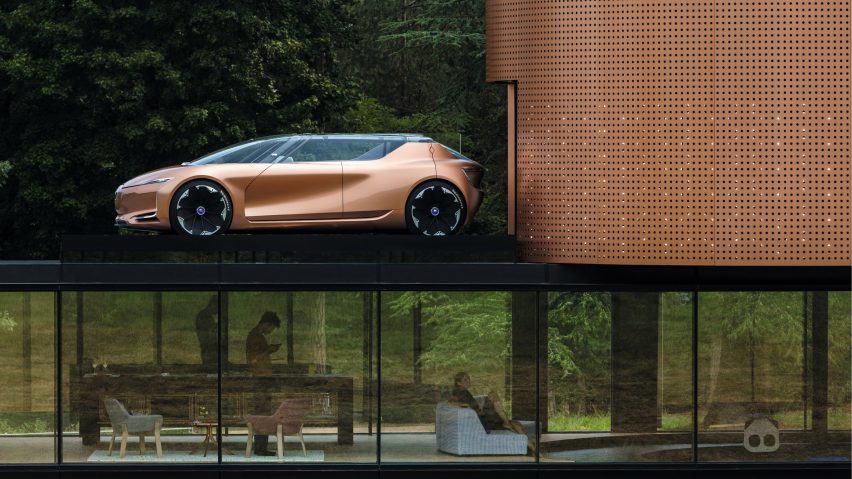The Frankfurt Motor Show 2017 kicked off in Germany yesterday. Here's a look at five of the most impressive car designs on show, including a car-share for the future and a vehicle envisioned as an extra living room.
The International Motor Show Germany takes place in Frankfurt every other year and is one of the biggest events in the automotive design calendar, where brands including BMW, Audi and Renault launch new concept designs and production vehicles.
With the recent news that Volvo, Jaguar Land Rover and BMW will all be releasing all-electric car ranges in the next eight years, the focus of this year's event is on electrification – most companies showcased solely battery-powered or hybrid vehicles. Autonomous cars were also out in force.
Frankfurt Motor Show 2017 takes place at the Messe Frankfurt exhibition centre. It is open to the public from 16 to 24 September 2017.
Here's our pick of the top five designs:
Renault Symbioz
Renault has revealed an autonomous, electric concept car that it sees as an extension of the home – the company describes the vehicle as "an extra mobile, modular and multi-purpose room".
The car's exterior is designed to resemble the architecture of the contemporary home, with a steel frame, expansive windows and wooden joinery details. The vehicle also connects to the home wirelessly, just like many of today's domestic appliances.
Inside, the living-room-inspired interior – finished in copper, marble, fabric and porcelain – includes four seats that can pivot to face each other. The design also includes a platform that allows the car to be lifted up onto a roof terrace.
"The aim is to travel in a bright, fengshui space that is much like a large living room in a house, with wide glazed contours," said Renault.
Smart Vision EQ ForTwo
Smart has envisioned a different approach to car sharing with this autonomous, electric, two-seater concept vehicle.
Designed to bridge the gap between public and personal transport, the EQ ForTwo offers even more personalisation than current car-share schemes like Uber – the Black Panel Grille at the front of the vehicle allows the user to recognise "their" car by displaying their name on it.
The new vehicle has no steering wheel or pedals, freeing passengers from the thought – let alone the task – of driving. This also allows more interior space for passengers to relax in.
"The Smart Vision EQ ForTwo is our vision of future urban mobility," said Smart CEO Annette Winkler. "It is the most radical car-sharing concept car of all: fully autonomous, with maximum communication capabilities, friendly, comprehensively personalisable and, of course, electric."
Honda Urban EV Concept
Honda's new electric city car is set to go on sale just two years from now. Honda president and CEO Takahiro Hachigo announced at the show: "This is not some vision of the distant future; a production version of this car will be here in Europe in 2019."
The vehicle's design is futuristic but nostalgically retro, referencing Honda's 1970s Civic and N600 models.
The car's low and wide proportions give it a "planted, muscular stance", suggesting it will provide a sporty driving performance. It is slightly smaller than the Jazz Supermini, measuring 3.9 metres long.
The Urban EV can accommodate four passengers across two bench seats, which may change to five when the production version is released. Interactive messages can be displayed on a screen at the front of the car, including greetings, advice for other drivers on the road and charging status updates.
Audi Aicon
With no steering wheel and no pedals, the only human intervention required in Audi's electric self-driving Aicon concept vehicle is the use of the touch-sensitive control panel that allows passengers to watch films, search the internet, make video calls or use social media.
Audi sets the Aicon apart from "robot taxis", which are reduced to functionality alone, by emphasising the car's interior, which it describes as having the "luxurious ambiance of a first-class airline cabin." It features seats that can slide back and forth, to change it from a two-seater to a four-seater.
According to Audi, the car could cover distances of 700 to 800 kilometres (435 to 497 miles) on a single charge, and could be charged to 80 per cent of capacity in less than 30 minutes.
BMW i Vision Dynamics
After announcing its plans last week to release 12 pure-electric cars by 2025, BMW gave the public a taster of these future models could be like.
Its new i Vision Dynamics concept car is a four-door Gran Coupe with a range of 600 kilometres (373 miles), a top speed of over 200 km/h (120 mph) and acceleration of 0-100 km/h (62 mph) in four seconds. It has been described by critics as a competitor for Tesla.
"With the BMW i Vision Dynamics, we are showcasing how we envisage future electric mobility between the i3 and i8," said Harald Krüger, CEO and chairman of BMW. "We are therefore electrifying the heart of the BMW brand and, at the same time, elevating BMW i into a totally new dimension."
According to BMW, the i Vision Dynamics will still keep the classic BMW proportions, "a long wheelbase, flowing roofline and short overhangs create a basic profile brimming with elegance and dynamism".

